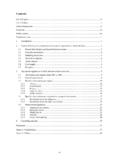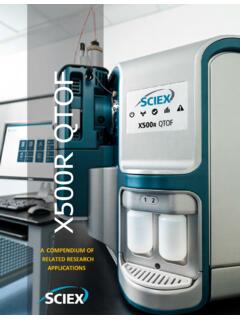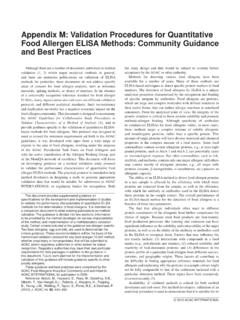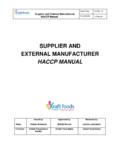Transcription of Manual on the application of the HACCP ystem in …
1 Manual on the application of the HACCP ystem in mycotoxin prevention and control FAO/IAEA TRAINING AND REFERENCE CENTRE FOR FOOD AND PESTICIDE CONTROL Food and Agriculture Organization of the United Nations Rome, 2001 FOREWORD Mycotoxins are considered to be among the most significant food contaminants with regard to their negative impact on public health, food security and the national economy of many countries, particularly the developing ones. They affect a wide range of agricultural products, including cereals, dried fruits, nuts, coffee beans and oilseeds, which are the backbone of most developing economies. These major crops are highly susceptible to fungal contamination and mycotoxin production.
2 mycotoxin contamination of susceptible commodities occurs as a result of environmental conditions in the field as well as improper harvesting, storage and processing operations. The Hazard Analysis Critical Control Point ( HACCP ) system has been increasingly and successfully applied by the food industry and by official food control authorities to prevent and control risks associated with potential contamination of food products with pathogenic micro-organisms and chemical toxicants. Food safety programmes routinely use information about the factors leading to contamination to establish preventive and control procedures, thus providing the consumer with a safe, wholesome food supply.
3 This Manual was prepared by the Food and Agriculture Organization of the United Nations (FAO) and the International Agency for Atomic Energy (IAEA) through their joint FAO/IAEA Training and Reference Centre for Food and Pesticide Control. Its main aim is to provide guidance to those countries/institutions wishing to apply the HACCP approach to mycotoxin prevention and control. The text and case studies were prepared by M. Pineiro of the Laboratorio Tecnologico del Uruguay, Ave. Italia 6201, Montevideo, Uruguay and M. Nagler, R. Coker, L. Nicolaides, P. Wareing and R. Myhara of Natural Resources Institute, University of Greenwich, Medway University Campus, Central Avenue, Chatham Maritime, Kent ME4 4TB, United Kingdom.
4 The Manual benefited from the peer review and comments of M. Olson, Swedish National Food Administration, D. Park, University of Louisiana and E. Boutrif, Food Quality and Standards Service, FAO. The examples presented in this Manual have been based on real case studies and aim to illustrate the application of HACCP specifically for mycotoxin control. It must be emphasised that these HACCP plans are only examples and are for guidance and training only. Every HACCP plan must be developed following the 12 tasks, and applying the seven principles of HACCP as defined by the Codex Alimentarius Commission. It is unlikely that any two HACCP plans will be identical, even for the same product.
5 IiiiTABLE OF CONTENTS PagePreface iii Chapter 1: An introduction to mycotoxins 1 What are mycotoxins? 1 Mycotoxicology - a systems approach 2 Mycotoxins of world-wide Importance 6 !
6 Aflatoxins 7 !Tricothecenes 11 !Zearalenone 12 !Fumonisins 12 !Ochratoxin A 13 !Patulin 15 The co-occurrence of mycotoxins 15 Mycotoxins of regional importance 15 Chapter 2.
7 An overview of hazard analysis and critical control point ( HACCP ) 25 Introduction 25 Pre-requisite programmes 26 Basic principles of HACCP 29 Developing a HACCP plan
8 30 application of HACCP to mycotoxin control 36 Conclusions 41 Appendix I: Definition of terms 42 Appendix II: Tasks involved in developing HACCP system 45 Appendix III: Example of Form Description of a product and of its intended use 46 Appendix IV: An example of decision tree to identify CCPs 47 Appendix V: An Example of a HACCP Worksheet 48 Chapter 3: Illustrative examples of application of HACCP to mycotoxin control 49 Example 1: Yellow maize kernels - South East Asia 51 Example 2: Maize-based Animal Feed - South East Asia 63 iiExample 3: Copra cake and meal - Southeast Asia 72 Example 4: Commercially produced peanut butter, Southern Africa 82 Example 5: Apple juice (Apple drink) - South America 91 Example 6.
9 Pistachio nuts in West Asia 101 References 113 List of tables:Table 1: Moulds and mycotoxins of world-wide importance 7 Table 2: Moulds and mycotoxins of regional importance 16 Table 3: Product description and intended use of yellow maize kernels 52 Table 4: HACCP Plan Worskheet - Aflatoxin in yellow maize kernels for animal feed 60 Table 5: Product description and intended use for maize-based animal feed 63 Table 6: HACCP Plan Worksheet: Maize-based animal feed Southeast Asia 71 Table 7: Product description and intended use for Copra cake and meal 73 Table 8: HACCP Plan Worksheet for Copra by-products Southeast Asia 80 Table 9: Product description and intended use for peanut butter Southern Africa 83 Table 10: HACCP Plan Worksheet for peanut butter Southern Africa 89 Table 11: Description and intended use of Apple juice South America 92 Table 12: HACCP Plan Worksheet Apple Juice 95 Table 13: Product description and intended use for pistachio West Asia 103 Table 14: HACCP Plan Worksheet for Pistachio nuts, roasted- West Asia 111 List of Figures:Figure 1.
10 The Commodity System 3 Figure 2: The Spoilage System 4 Figure 3: The mycotoxin System 6 Figure 4: The Chemical structure of some important mycotoxins 8 Figure 5: The structure of cyclopiazonic acid 10 Figure 6: The Control System 19 Figure 7: Food Safety Tools: an integrated approach 20 Figure 8: HACCP Flow-diagram: Yellow maize in Southeast Asia 53 iiiFigure 9: HACCP Flow-diagram: Maize-based feed in Southeast Asia 64 Figure 10: Verified commodity flow diagram for Copra cake and meal 74 Figure 11: HACCP Flow-diagram for Peanut Butter Southern Africa 84 Figure 12.

















